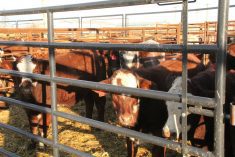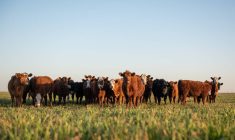“These measures address a real threat to the long-term profitability of the Canadian cattle industry.”
– BRAD WILDEMAN
Packers and cattle groups say assistance announced in the federal budget will make their sector more competitive.
The budget allocated an extra $10 million for the Slaughter Improvement Program, $25 million for packing plants that handle animals over 30 months of age and $40 million over three years to help packing plants get new technology for handling BSE specific risk material.
Steve Morin, president of the Canadian Meat Council, says Canadian packers have operated at a disadvantage to American rivals since the introduction of Canada’s enhanced ruminant feed ban in 2007. A council study released last year showed the industry was paying $26.2 million more a year than Ottawa estimated to comply with the new rules designed to keep BSE material out of the food chain.
Read Also

Pig transport stress costs pork sector
Popular livestock trailer designs also increase pig stress during transportation, hitting at meat quality, animal welfare and farm profit, Agriculture and Agri-Food Canada researcher says
“These regulatory requirements imposed tremendous ongoing disposal costs and loss of revenue in animal feed to our beef-packing sector not faced by the American packers to the south,” Morin said in a statement.
Morin also applauded the new Agriculture Market Access Secretariat at Agriculture Canada and the efforts by Agriculture Minister Gerry Ritz to reopen overseas markets to Canadian beef.
The meat industry will also benefit from a $250-million investment in upgrading and modernizing federal laboratories doing research in areas including health and food safety, he said. Eliminating tariffs on new machinery and equipment will allow packers to retool their plants.
The Canadian Cattlemen’s Association said the assistance for processing cattle over 30 months of age goes a long way to meeting the request of farm groups.
“The budget measure of $25 million to manage the cost of processing over 30-month cattle will help to address this issue in the short term,” said CCA president Brad Wildeman. “Long-term change, including regulatory alignment with the U. S., also needs to occur.”
It costs more to slaughter an OTM animal in Canada than in the United States, due to the different approaches the two countries take in disposing of specified risk materials (SRM). The cost of collecting and disposing of SRM in Canada has been a major issue since 2007, he said. Cattle-processing plants have closed, scaled back or changed policy to deal with the added costs.
The support for new technology to manage SRM material is welcome as well, he noted. “These measures address a real threat to the long-term profitability of the Canadian cattle industry. We hope as we transition to a more North American regulatory environment this will help to keep Canadian cow processing in Canada.”
Jacques Laforge, president of Dairy Farmers of Canada, said the government “really stepped up to the plate” with the packer assistance. The government listened to “dairy and beef producers’ requests for assistance to alleviate the cost disadvantage we face in processing our cattle.”
The money should be dispersed quickly, he added, to maintain slaughter capacity and reduce the impact of the SRM requirements,” he said. “It’s a commitment to innovation in our industry to help develop new technologies to generate revenues from SRM and reduce costs. In the end, all Canadians will benefit from this government action through even better quality and safety standards in the food chain.”
The Canadian SRM rules prevent the use of SRM in animal feed, pet food and fertilizers to eliminate the potential for cross-contamination. The regulations also prohibit the exportation of animals, animal products and products of rendering plants without a certificate. A similar feed ban was adopted by the United States, but with a shorter list for SRMs, putting Canadian dairy and beef cattle producers at a cost disadvantage.


















